For many, the most memorable “train
experience” of 2019 will go down as seeing the Union Pacific Big Boy #4014 steam locomotive in action. After many years of
hard work by Union Pacific's "Steam Team", the world's largest
operating steam locomotive made its debut this year... just in time for the 150th
Anniversary of the Golden Spike in Utah. Following that, in late July and early August
2019, it went on a tour of several mid-western states, including Wyoming, Nebraska, Iowa, Minnesota, Wisconsin, and Illinois.
Like probably many of you who are reading this article on
TrainWeb.com right now, we thought about going out to Promontory Point, Utah for the
150th Anniversary of the Golden Spike on May 10, 2019. Unfortunately, it didn’t quite
work out. We had prior travel commitments that weekend… plus we simply
didn’t want to deal with the massive crowds that we heard were
forecasted to attend. On top of it, we had just visited Golden Spike
National Historical Park about two years ago on a separate trip to the
National Park Service units of the Inter-Mountain West… and didn’t want to spend the
money going back to some place we had just traveled to.
Anyway… we were quite happy to learn that the Union Pacific Big
Boy #4014 would actually be coming to our neck of the woods for a visit
in July! Count us in!
The first chance we had to see the Big Boy #4014 was on Thursday, July
25, 2019 when it was making its way between Altoona, Wisconsin and
Milwaukee, Wisconsin. We decided to stake out a grade crossing (Marcy Road) in the
town of Menomonee Falls (about 25 miles northwest of Milwaukee) to watch it come
in around 12:45pm. We picked a rather rural crossing and thought we
might be the only ones out there... but to our surprise around 50 other
people would also be joining us! The local news media in
Milwaukee did a pretty good job about getting the word out about the
steam engine coming through. A lot of people lined various grade
crossings in Southeast Wisconsin because the Big Boy #4014 would not be
making any public stops in the area. The train overnighted in the
Bulter, Wisconsin UP Yards northwest of Milwaukee... but given the
set-up of the yards... it was not really practical to have the general
public come out and tour. So unless someone from Southeast Wisconsin
wanted to drive to Chicago... going to watch it comes through at a
grade crossing was going to be about the only option.
 Union Pacific Big Boy #4014 makes its way through Menomonee Falls, Wisconsin around 12:45pm on Thursday, July 25, 2019
Union Pacific Big Boy #4014 makes its way through Menomonee Falls, Wisconsin around 12:45pm on Thursday, July 25, 2019

The Midwest Rail Rangers put up our new drone to catch the Union Pacific Big Boy #4014 come through Menomonee Falls, Wisconsin
Later on the evening of Thursday,
July 25, 2019, we paid a visit to Butler, Wisconsin (just northwest of
Milwaukee) to see the Big Boy #4014 in the Union Pacific Yards there.
Even though there were no public events scheduled... we heard that you
could safely view the steam engine behind a strip mall near U.S. 41/45
and Capitol Drive (WI Highway 190). We arrived around 7:00pm and found
numerous people also enjoying the view of the Big Boy. We wish there
were some sort of public event in the Milwaukee area, but the Union
Pacific "steam team" decided there was no real safe public space in the
Milwaukee area to host an open house or photo sessions.
 Midwest Rail Rangers Educational Officer Kandace Tabern poses with the Big Boy on July 25, 2019 in Butler, Wisconsin
Midwest Rail Rangers Educational Officer Kandace Tabern poses with the Big Boy on July 25, 2019 in Butler, Wisconsin
We decided to get up early on
Friday, July 26, 2019 and see the Big Boy #4014 once again... as it
made its way from Butler, Wisconsin to West Chicago, Illinois. Using
Google Maps, we determined that one of the best locations for viewing
would be near the intersection of 57th Street and Mobil Street in West
Allis, Wisconsin. After a slight delay leaving the Butler yards, the
historic steam locomotive rolled through West Allis around 8:45am. The
Union Pacific actually owns two lines between Milwaukee and Chicago. We
were hoping that it would take "the old route" (Kenosha Subdivision)
which runs closer to Lake Michigan and heads through Downtown Racine,
Kenosha, Lake Bluff, and Evanston. Due to this line not being in as
good shape as "the new line" (Milwaukee Subdivision), we learned that
the Big Boy #4014 would have to slow down to just 10mph at a lot of
bridges if it took the "old route"... so it was routed on to the "new
line" which heads through more rural areas between the "old line" and
the Canadian Pacific line used by Amtrak.
 The Union Pacific Big Boy #4014 makes it way through West Allis, Wisconsin on the morning of Friday, July 26, 2019
The Union Pacific Big Boy #4014 makes it way through West Allis, Wisconsin on the morning of Friday, July 26, 2019
While we enjoyed our three quick brushes with the Big Boy #4014 in
Wisconsin on Thursday and Friday, the "main event" we were really
looking forward to was visiting West Chicago, Illinois on the morning
of Saturday, July 27, 2019. The Union Pacific was kind enough to invite
"Midwest Rail Rangers on Trainweb.com" to have special
behind-the-scenes media access to cover the historic steam locomotive's
appearance at the Larry S. Provo Training Center. In attendance to help
cover the event was Midwest Rail Rangers President Robert Tabern,
Midwest Rail Rangers Treasurer Dave Poole, and Midwest Rail Rangers
Educational Officer Kandace Tabern.
The highlight of the morning was getting the chance to have a
one-on-one interview with Ed Dickens, Union Pacific's Senior Manager of
Heritage Operations. Ed not only is the locomotive engineer for the Big
Boy #4014... he was also instrumental in leading the "Steam Team"
restoration efforts of the locomotive.
To watch an eight minute long video clip of our interview with Ed, head to our Facebook page!
(http://www.facebook.com/railrangers)
Ed began our interview by explaining some of the basics about the Big Boy #4014. It is a type of
articulated steam locomotive manufactured by the American Locomotive
Company between 1941 and 1944 and operated by the Union Pacific in
revenue service until 1959. The 25 Big Boy locomotives were built to
haul freight over the Wasatch Mountains between Ogden, Utah and Green
River, Wyoming. After a few years in service there, they were
re-assigned to Cheyenne, Wyoming, where they hauled freight over
Sherman Hill to Laramie, Wyoming. One of the things that made them so
special was that they were the only locomotives to use a 4-8-8-4 wheel
arrangement: four-wheel leading truck for stability entering curves,
two sets of eight wheels and a four-wheel trailing truck to support the
large firebox.
According to Ed, when his Union Pacific “Steam Team” decided to
bring a Big Boy back to life, they knew
from the beginning the 4014 was the only real practical candidate and
therefore pursued it alone. Ed never contacted any other museum or
traveled anywhere to look at another Big Boy. The 4014 was the one Ed
wanted from the beginning.
Of the 25 Big Boys built, only eight are in existence. They include the following: #4004 at the U.S. 30
Holiday Park in Cheyenne, Wyoming; #4005 at the Forney Transportation
Museum in Denver, Colorado; #4006 at the Museum of Transportation in
St. Louis, Missouri; #4012 at Steamtown National Historic Site in
Scranton, Pennsylvania; #4014 at the Rail Giants Train Museum in
Pomona, California; #4017 at the National Railroad Museum in Green Bay,
Wisconsin; #4018 at the Museum of the American Railroad in Frisco,
Texas; and #4023 at Lauritzen Gardens in Omaha, Nebraska.
Of course, the engine that made “the cut” for restoration was the #4014
at the Rail Giants Train Museum in suburban Los Angeles… where it had
been located for 52 years at that point.
Dickens said, “I wanted the
4014 over all the other Big Boys for this reason: It had less corrosion
and it was less worn out. Some of the machines on other locomotives
were a little bit better, but on balance the boiler was in the best
condition. When you’re talking about a big 300-pound-pressure vessel,
you want to have 100 percent of that boiler in the best condition you
can make it.” To their surprise, Rail Giants and Big Boy alumni
had been lubricating the 4014’s running gear for decades in hopes it
might one day run again.
Union Pacific acquired the 1.2 million-pound locomotive in 2013 and
spent about two-and-a-half years bringing it back to life. After making
its first post-restoration run in May -- a celebration of the 150th
anniversary of the Transcontinental Railroad's completion -- the Big
Boy went on its "Great Race Across the Midwest".
Things wrapped up on Thursday, August 8, 2019, when the Big Boy #4014 arrived back at the UP Steam Shops in Cheyenne, Wyoming.
UPP 814 Joe Jordan Water Car & UPP 809 Jim Adams Water Car (with US Flag)
 Union Pacific Water Car "Joe Jordan"
Union Pacific Water Car "Joe Jordan"

Union Pacific Water Car "Jim Adams"
UP SD70ACe-T4 Diesel Locomotive #3025
The Union Pacific also decided to include a modern SD70ACe-T4 diesel
locomotive in the consist of the Big Boy 4014 Excursion Train to
provide extra power, if needed. UP #3025 weighs 428,000 pounds and can
reach a top speed of 75 miles-per-hour. The Union Pacific had 100 of
these types of engines built by ElectroMotive, with the first being
delivered in November 2016. Some of the units are in active service
while others remain in storage.
Union Pacific #6334 "Art Lockman" Tool Car
The “Art Lockman” was built in 1962 by the St. Louis Car Company as
baggage car #6334. It was one of the last baggage cars purchased by
Union Pacific. The car was converted to a tool car for snowplow service
and renumbered #904304 in 1973. It was assigned to the Heritage Fleet
in 1981. The car was named “Art Lockman” in 1992 and was re-numbered
#6334 in 2003. The Art Lockman is essentially a rolling machine shop.
It carries tools, parts, machines, lubricants and numerous other items
to maintain and repair the steam locomotive while on trips. The car
also has a crew lounge area, locker room and laundry area. Mr. Lockman
retired as roundhouse foreman in Cheyenne, Wyoming, after working 43
years for Union Pacific. He is a well-known former employee who is
still admired for his knowledge of steam locomotive maintenance and
operation.
Union Pacific #209 "Howard Fogg" Power Car
The “Howard Fogg” is Union Pacific’s last boiler car. It was built in
1949 by American Car & Foundry as baggage-dormitory #6006. The
“Howard Fogg” was converted to boiler-baggage-dorm #304 in 1962. The
car was converted to boiler-dorm-HEP (Head End Power) in 2000. It was
renumbered again in 1987 to #209 and assigned to the Heritage Fleet in
1990. In 1996, it was renamed “Howard Fogg” after the passing of the
renowned railroad artist. The “Howard Fogg” still has a steam generator
onboard to provide steam if maintenance is required while the Big Boy
locomotive is on the road. The car has been outfitted with an electric
generator Steam Locomotive Support Cars to provide electricity to the
passenger cars. It also has three sleeping rooms, a shower, a laundry
room and a small lounge area for the crew’s use while on extended
trips, such as the Midwestern Big Boy Tour.
Union Pacific #5714 "Lynn Nystrom" Baggage Car

“Golden State Limited” train began service on November 2, 1902. It was
touted as having many innovations through the entire train, from the
engine to observation platform on the rear car. Today, the “Golden
State Limited” is used to transport supplies during excursions. The car
was re-named “Lynn Nystrom” in May 2010 in honor of one of the Union
Pacific Steam Team’s engineers who suddenly passed away that same
month. Lynn began his railroad career with the Rock Island Railroad in
1968 as a special agent. He joined Union Pacific as a
switchman/brakeman in June, 1977 and began part-time as a fireman on
the Steam Crew in 1989. Lynn was promoted to conductor in January 1992
and assigned to the Steam Crew full-time as fireman in September that
same year. He qualified as a diesel locomotive engineer in December
1998, and steam locomotive engineer in 2003. According to many we spoke
with on the train in West Chicago, Lynn will always be known as a
friend to the model railroad, railroad and rail enthusiasts communities.
Union Pacific #7015 "Challenger" Dome Coach
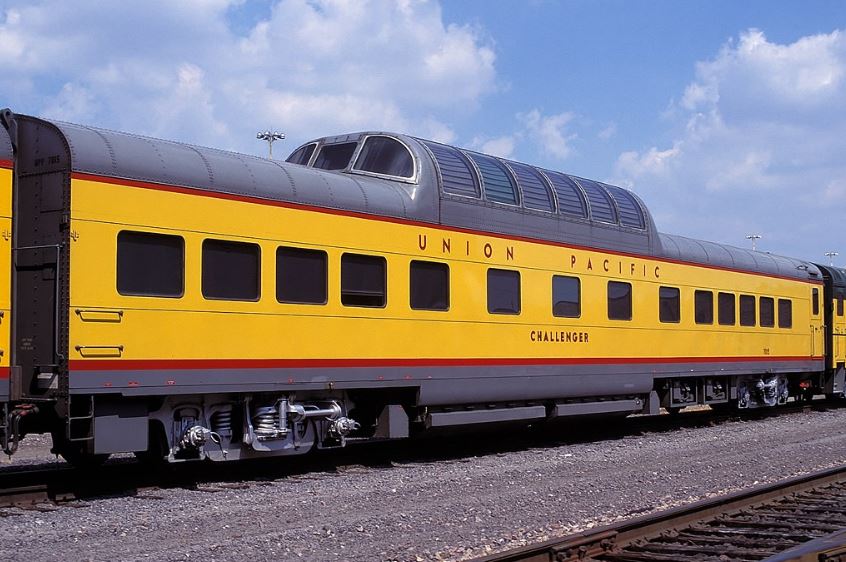 (Photo Courtesy: Paul Rome)
(Photo Courtesy: Paul Rome)
One of the two dome cars seen in the consist of the Big Boy 4014 tour
stop at West Chicago was the “Challenger” dome-coach. “The Challenger”
was built by Pullman Standard in 1958 as dome coach #7015. This car is
very historic, as this was the last dome car ever built. It was
re-acquired by Union Pacific in 1989. The “Challenger” passenger
trains, known as “Everybody’s Limited,” were introduced in the middle
of the Depression in an attempt to draw ridership back to the rails.
The equipment was spartan and the meal service was advertised as “three
meals for under a dollar a day.” There was good food and plenty of it,
but it wasn’t the first-class fare of the streamliners, where one meal
might cost $1.25. The introduction of the “Challenger” also marked the
advent of registered-nurse-stewardess service in August 1935. These
single women were charged with first-aid service for the entire train,
but their main function was to assist women with small children and
children traveling alone. They were paid $125 per month plus expenses.
The track also featured exclusive coaches for women and children at the
head of the train, thus eliminating the need for men to even walk
through the cars. Even though it was called the “Challenger”, during
its first months of operation, the rail car ran as the second section
to the “Los Angeles Limited”. In May 1936, the “Challenger” was given
its own number and began to run individually. In 1937, the “San
Francisco Challenger” was added. As dome cars were acquired, the
“Challenger” became the “Challenger Domeliner” and ran until 1971.
Union Pacific "Promontory" Exhibit Car

One of the highlights for those attending the Big Boy 4014 Event in
West Chicago was the chance to view exhibits in the “Experience the
Union Pacific Rail Car”. This car was open to the public at some of the
extended stops along the Midwest Tour Route, including Minneapolis-St.
Paul and other locations. It provides a glimpse at the past while
telling the story of modern-day railroading in a multi-media
walk through exhibition. Through sound, images and interactive
technology, visitors could see how Union Pacific is building America in
their communities and throughout the world. Upon entering the converted
baggage car, patrons first learn about the investment, hard work and
know-how that went into building the transcontinental railroad.
Historical photos and info graphics bring our nation’s history to life
in a fun, engaging way. Moving forward along one wall, rail fans learn
about the evolution of the locomotive, beginning with the world famous
Union Pacific #119 and leading to modern-day diesel powerhouses. The
opposite wall illustrates how trains deliver fresh apples from
California and Washington to New York, outlining every aspect of rail
operations and innovation along the way. Interactive technology shows
how Union Pacific uses lasers, cameras and other detection devices to
accurately inspect moving rail cars and track. Visitors can test their
skills to see how they measure up as rail car inspectors. Before
leaving, exhibition-goers can show Union Pacific how they connect to
the railroad using high-tech, thermal reactive tiles. A final display
celebrates the history of Union Pacific’s Passenger Heritage Fleet
through vintage photos. Built by the St. Louis Car Company in 1962,
#5752 was originally used to transport mail by the U.S. Postal Service.
In the 1970’s, Union Pacific’s Maintenance of Way team transitioned the
unit into a tool car and renumbered it #904277. It was retired from
service in the 1990’s and stored at Union Pacific’s Coach Shop in
Council Bluffs, Iowa. It became Promontory Exhibition Car #5752 in
October 2018.

Union Pacific #1602 "Green River" Sleeping Car

What is now “Green River” Sleeping Car #1602 was actually built by the
American Car and Foundry Company in December 1949 as a sleeper called
“Western Hills”; it contained 12 roomettes and four double bedrooms. In
1965, the Union Pacific decided to have the car remodeled by
Pullman-Standard to feature 11 bedrooms. When this work was finished,
it was re-named “Sun Isle” and assigned #1602. After regular passenger
service moved to Amtrak in 1971, this car remained with the Union
Pacific for use in special service in its business fleet. In
1983, the car was partially stripped for use as an office car. That
conversion was never completed and the car was stored without its
trucks until being sold off to Katsen Rail Services in 1988, which
intended to use the car for service as part of Classic Rail
Tours. For whatever reasons, the car could not be moved… so it
was traded back to the Union Pacific in August 1990 for another car.
The following year, it was converted to Deluxe Sleeper #1602 “Green
River”; it currently features eight bedrooms. The name “Green River”
comes from the city of Green River, Wyoming, the site of a large
freight yard and extensive car and locomotive repair facilities. Green
River was the division point where trains to and from subsidiary Oregon
Short Line connected with the Union Pacific’s mainline across Wyoming.

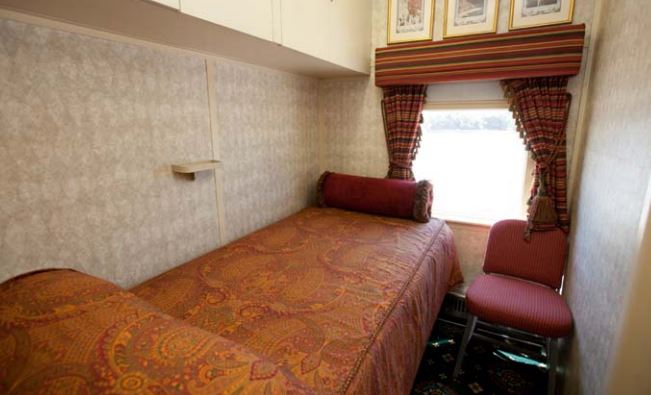 (Last Photo is Courtesy: Union Pacific Railroad)
(Last Photo is Courtesy: Union Pacific Railroad)
Union Pacific Power Car #2066
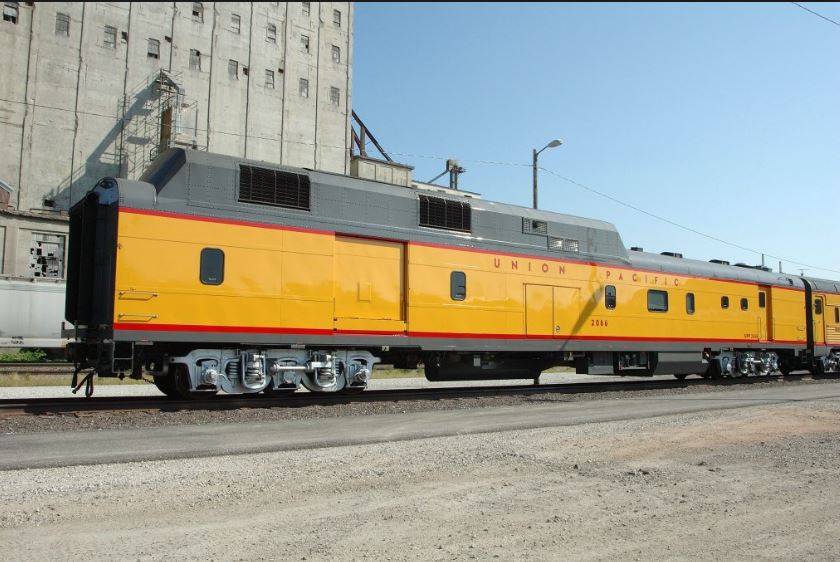
(Photo Courtesy: Paul Rome)
Many of those attending the Big Boy 4014 events had a lot of questions
about Power Car #2066, which looked like something many had never seen
before. It was originally built as postal storage car #5816. Steam
locomotives had supplied passenger cars with the steam needed for heat
and hot water, but after diesel locomotives were phased in, steam
generators were required. They were placed in baggage cars at the front
of trains. Locomotive auxiliary generators provided 32-volts of
electrical power for the passenger cars that could be “stored” for
short periods of time in batteries underneath each car. As Union
Pacific’s passenger equipment was modernized and the need for electric
power grew, steam generator cars were rebuilt into diesel-electric
generator cars that provide electricity to the entire train. Each
passenger car is connected to the power car using a series of “jumper
cables” between each car. Some of Union Pacific’s passenger cars are
equipped with their own electric generators, allowing them to operate
without a power car. Power cars also have living quarters for an
electrician who monitors the system, and additional refrigerators and
freezers for commissary services.
Union Pacific "Walter Dean" Dome Car

One of our favorite cars on the Big Boy 4014 Tour Train was no doubt
the “Walter Dean” dome/lounge, especially because of the luxurious
seats up in the dome car. The “Walter Dean” was built in 1955 by
American Car & Foundry as Union Pacific Dome/Lounge #9005. It was
sold to Auto Train, then re-acquired by Union Pacific and named the
“Walter Dean” in 1990. The car is named for Walter Dean, who began his
service with Union Pacific in 1942 as a dining car waiter on the
“Challenger”. At that time, the dining car crew slept in the dining
cars and kept mattresses in a hole under the floor. When Mr. Dean moved
into the lounge car on the “City of Los Angeles” as attendant, he was
responsible for stocking and maintaining the bar and providing service
to the passengers. His clientele included such stars as Mickey Rooney,
Judy Garland and Frank Sinatra, who frequently traveled on the train.
He also served President Harry Truman during his “Whistle Stop
Campaign” of 1948. When passenger service ended in 1971, Mr. Dean
remained with Union Pacific, serving special guests and staff on
business car trips that operate for railroad, corporate and community
relations events. He passed away on October 18, 1999.
Union Pacific "City of Denver" diner/lounge

We also got a tour of the “City of Denver” diner/lounge car… where we
were told most of those working on the Big Boy 4014 tour got to eat
their formal meals together. The “City of Denver” was built in 1959 by
the St. Louis Car Company as lunch counter cafe and lounge #5011. The
City of Denver operated until Union Pacific ended its passenger service
in 1971, when Amtrak took over most of the nation’s passenger train
business. The car was sold to Golden Wool Company in 1972. Union
Pacific re-acquired the car in 1989, when it was rebuilt into a 36-seat
dining car and named the “City of Denver”. Settlement began in the area
around Denver in 1858 when a prospecting party from Lawrence, Kansas
built cabins along the South Platte River. The Denver City Town Company
was organized on Nov. 17, 1858, by General William Larimer and named
for General James W. Denver, territorial governor of Kansas. In 1880,
Union Pacific gained access to the Denver market with the acquisition
of the Denver Pacific Railroad. This railroad, built from Cheyenne,
Wyoming to Denver and then east, in 1871 joined the Kansas Pacific
Railroad coming west from Kansas City, Missouri. The streamliner
passenger train “City of Denver” made its inaugural trip between
Chicago and Denver on June 18, 1936. This 12-car train covered the
1,048 miles in just 16 hours, making it the fastest regularly scheduled
long-distance passenger train in the world, a record that still stands.
The lounge car on the train features an Old West theme with pictures of
cowboys and outlaws, wanted posters and other memorabilia of the
frontier.



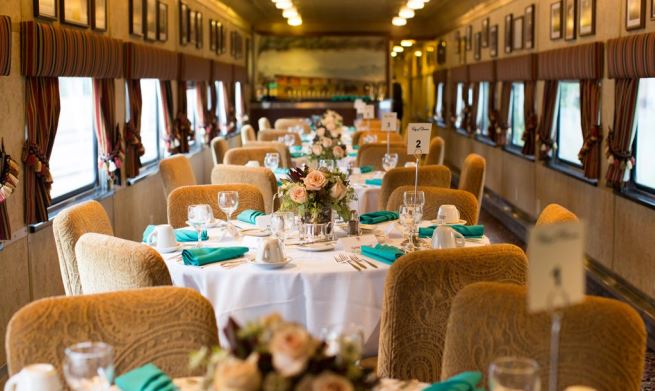 (Last Photo is Courtesy Union Pacific Railroad)
(Last Photo is Courtesy Union Pacific Railroad)
Union Pacific Business Car "Kenefick"

Bringing up the rear of the train was “Kenefick”, a business car that
featured an open platform on the back… affixed to it was a special drum
head for the Big Boy 4014 Tour. This car was built by Pullman in 1950
as Coach Car #5446. It was re-built in April 1963 to be Business Car
#99. It was re-numbered to be Business Car #100 in May 1965 and
Business Car #119 in April 1986. The name “Kenefick” was added to the
car in 1988 in commemoration of John C. Kenefick, president of the
Union Pacific from 1971 to 1983. Kenefick was born in Buffalo,
New York, in 1921. After graduating from Princeton and completing a
stint in the Navy, he moved to Omaha, where he began working for Union
Pacific. By 1952, Kenefick was a train master at Salina, Kansas. He left
the Union Pacific that year for a job with Denver & Rio Grande,
staying until 1954. From there he worked for the New York Central
becoming vice president of operations in 1966. In 1968 he moved to the
Penn Central and then to Union Pacific, returning as vice president of
operations. Kenefick replaced cronyism with promotion by merit. In
1971, he became the railroad’s president, a position he held until
1983, when he became chairman of the new Union Pacific system, created
by the mergers with Missouri Pacific and Western Pacific. By then he
had long held a reputation as possibly the foremost railroad operating
man in the nation. His retirement from active service with the railroad
in 1986 marked the end of an era in the company’s history.



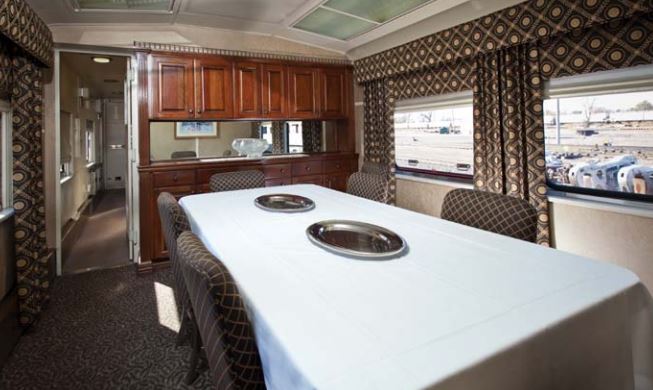 (Last photo is courtesy Union Pacific Railroad)
(Last photo is courtesy Union Pacific Railroad)

By
9:30am on Saturday, July 27, 2019 the crowd grew quite large at West
Chicago. Over three days, 45,000 visited the Big Boy #4014.
We ended up saying "goodbye"
to the Big Boy #4014 in Illinois by watching it passing through
Rochelle, Illinois on the Trains Magazine camera on Tuesday, July 30,
2019.
 The Union Pacific Big Boy #4014 passes through Rochelle on Tuesday, July 30, 2019
The Union Pacific Big Boy #4014 passes through Rochelle on Tuesday, July 30, 2019
(Courtesy: Trains Magazine Camera)
Even though the Midwest tour ended on August 8, 2019... we heard that
there are plans in the works to bring the Big Boy #4014 to Southern
California later this year. We look forward to hearing the schedule
released soon... maybe we will head out and ride!

















































